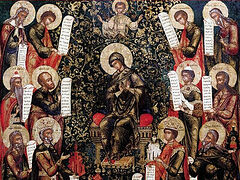 Schema-Igumen Ignaty (Kryukov)
Schema-Igumen Ignaty (Kryukov)
In the name of the Father, and of the Son, and of the Holy Spirit.
Today, on the Saturday of the fifth week of Lent, the Holy Church praises the Most Holy Theotokos in a special, solemn way. The service of this day is different from any other one. Those who attended Matins yesterday heard the reading and singing the Akathist hymn to the Mother of God, alternated with kathismas and the Canon. This festal service includes the solemn singing of the Akathist to the Mother of God, which is why the service is called the “Laudation of the Most Holy Theotokos”.
What is an akathist hymn? The Greek word “akathistos” translates as “unseated,” “standing,” that is, a hymn sung standing. The appearance of this akathist is traditionally associated with events that took place in Constantinople in the seventh century A.D. The city was surrounded by foreigners, and it seemed that nothing could help its inhabitants. Feeling the insufficiency of their strength, people turned to God and the Queen of Heaven in prayer, and help was not long in coming—the enemy was miraculously defeated.
In memory of the victory, the God-loving residents of the city of Constantinople celebrated thanksgiving; they sang hymns of praise in honor of the Mother of God all night long (before that, they used to sit while singing the hymn). From that time on, in memory of that great miracle, the feast of the Praise of the Most Holy Theotokos was established. The miraculous deliverance of the inhabitants of Constantinople took place during Lent, which is why the Akathist composed later was prescribed to be sung on the fifth Saturday of Lent. This first and most perfect of the akathists was composed at the same time—in the seventh century, on the basis of earlier kontakia, which celebrated the events of the Annunciation of the Mother of God and the Nativity of the Lord Jesus Christ. And the Holy Church established a service to celebrate and give praise to the Most Holy Theotokos while standing. Since then, this Akathist hymn has been read during Lent at services for the affirmation of the penitents, in the hope of the intercession of the Mother of God, Who, by delivering us from visible enemies, is all the more willing to help us in the fight against invisible foes.
As mentioned above, the sublime, poetic, divinely inspired virtue of the Akathist is apparently explained by the fact that it is based on more ancient kontakia and Patristic traditions that sing of the Mother of God. We do not know what kind of kontakia they were, but there is a surviving historical document in which praises are rendered to the Most Holy Theotokos with amazing power. It is a letter from a disciple of the Apostle Paul, Hieromartyr Dionysius the Areopagite, addressed to the Apostle Peter.
He wrote that when he was introduced to the supreme presence of the Virgin and saw Her radiant face, his heart was filled with such inexplicable joy and fullness of bliss, that if he had not been well instructed in the basics of the true faith, he would have considered Her a deity. The author says that if the contemplation had lasted a little longer, his soul would have separated from his body. He partook fully of the bliss of the age to come, and this was only a momentary contemplation of the Most Pure Virgin.
And as if continuing this contemplation in our time, one Church author and preacher, telling us about this event, exclaimed, “What a great reward St. John the Theologian received at the Cross from the Lord Who said, Behold thy Mother (Jn. 19:27), that in subsequent years he was always close to Her, protected Her, took care of Her, and was therefore always worthy to contemplate Her Most Pure Face; he always heard Her voice, which has the ability to soften hearts and raise even the most inveterate sinners to eternal life.”
Brothers and sisters, on this day it becomes us to read the Akathist hymn to the Most Holy Theotokos with special zeal and reverence, and offer praise and thanksgiving to the Most Pure Virgin in words taken from it. Everyone can find words that resonate in their hearts. For example, here are words from Ikos 7:
Rejoice, Thou Who gavest birth to the Guide of those astray!
Rejoice, supplication before the Righteous Judge:
Rejoice, forgiveness of many sinners!
Rejoice, robe of boldness for the naked:
Rejoice, love that vanquisheth all desire!
Rejoice, O Bride Unwedded!
Or Kontakion 1:
To Thee, the Champion Leader, we Thy servants dedicate a feast of victory and of thanksgiving as ones rescued out of sufferings, O Theotokos: but as Thou art one with might which is invincible, from all dangers that can be do Thou deliver us, that we may cry to Thee: Rejoice, O Unwedded Bride!
Amen.



